Criminology 100 Final Exam Assignment - UFV, Fall 2024
VerifiedAdded on 2022/10/17
|5
|1094
|9
Homework Assignment
AI Summary
This Criminology assignment addresses several key topics within the field. It begins by comparing and contrasting Western and Traditional Aboriginal Justice systems, highlighting potential disadvantages for Indigenous individuals within the Western system. The assignment then delves into the controversy surrounding solitary confinement in correctional institutions, discussing its implications and psychological effects on inmates. Furthermore, the document analyzes the implications of collaboration between separate criminal organizations on legislation, policing, media, and public awareness. The assignment also touches upon victim characteristics, and concludes with a summary of the Brian Shaw case. The document provides a comprehensive overview of these criminological concepts, supported by relevant references.
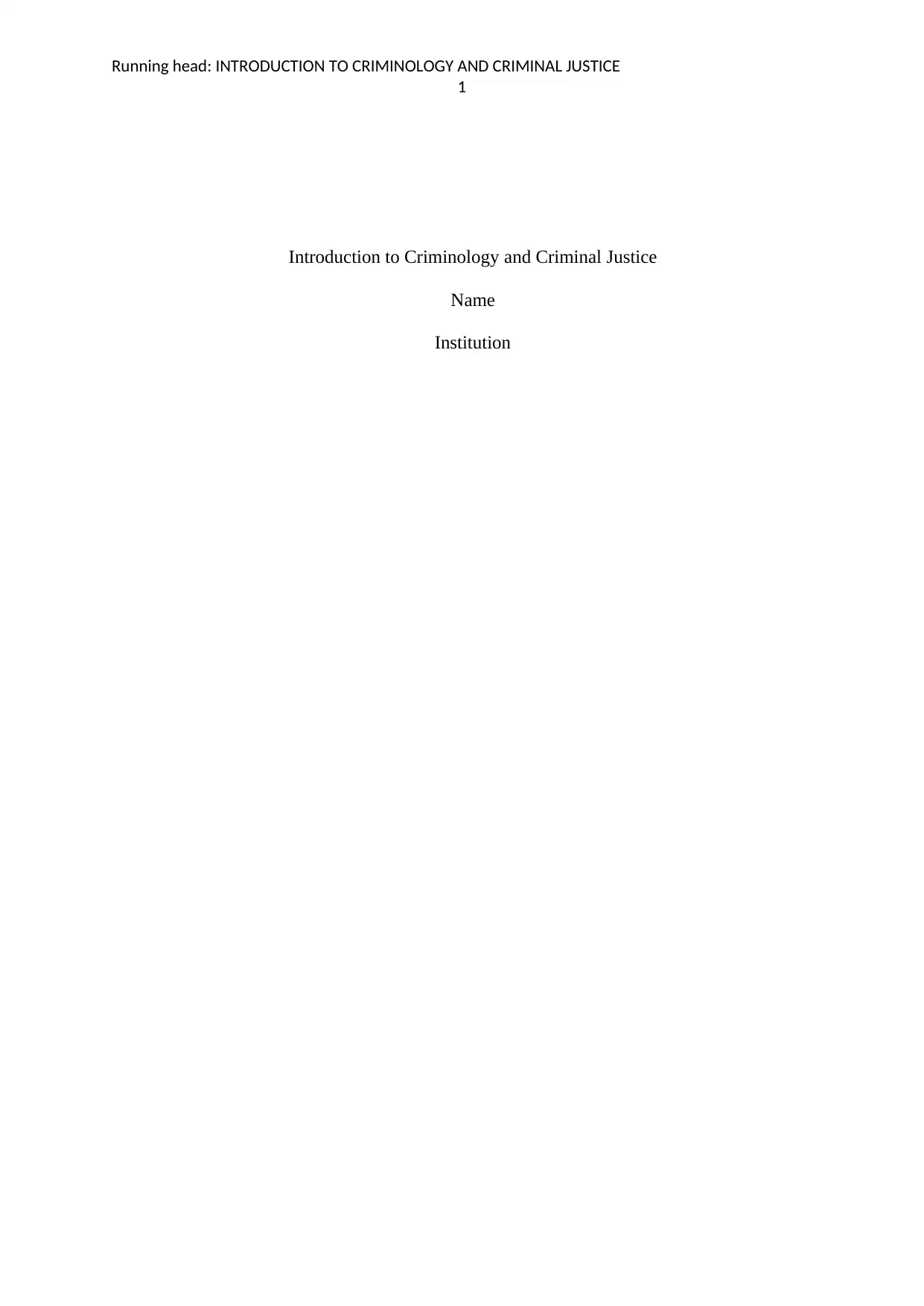
Running head: INTRODUCTION TO CRIMINOLOGY AND CRIMINAL JUSTICE
1
Introduction to Criminology and Criminal Justice
Name
Institution
1
Introduction to Criminology and Criminal Justice
Name
Institution
Paraphrase This Document
Need a fresh take? Get an instant paraphrase of this document with our AI Paraphraser
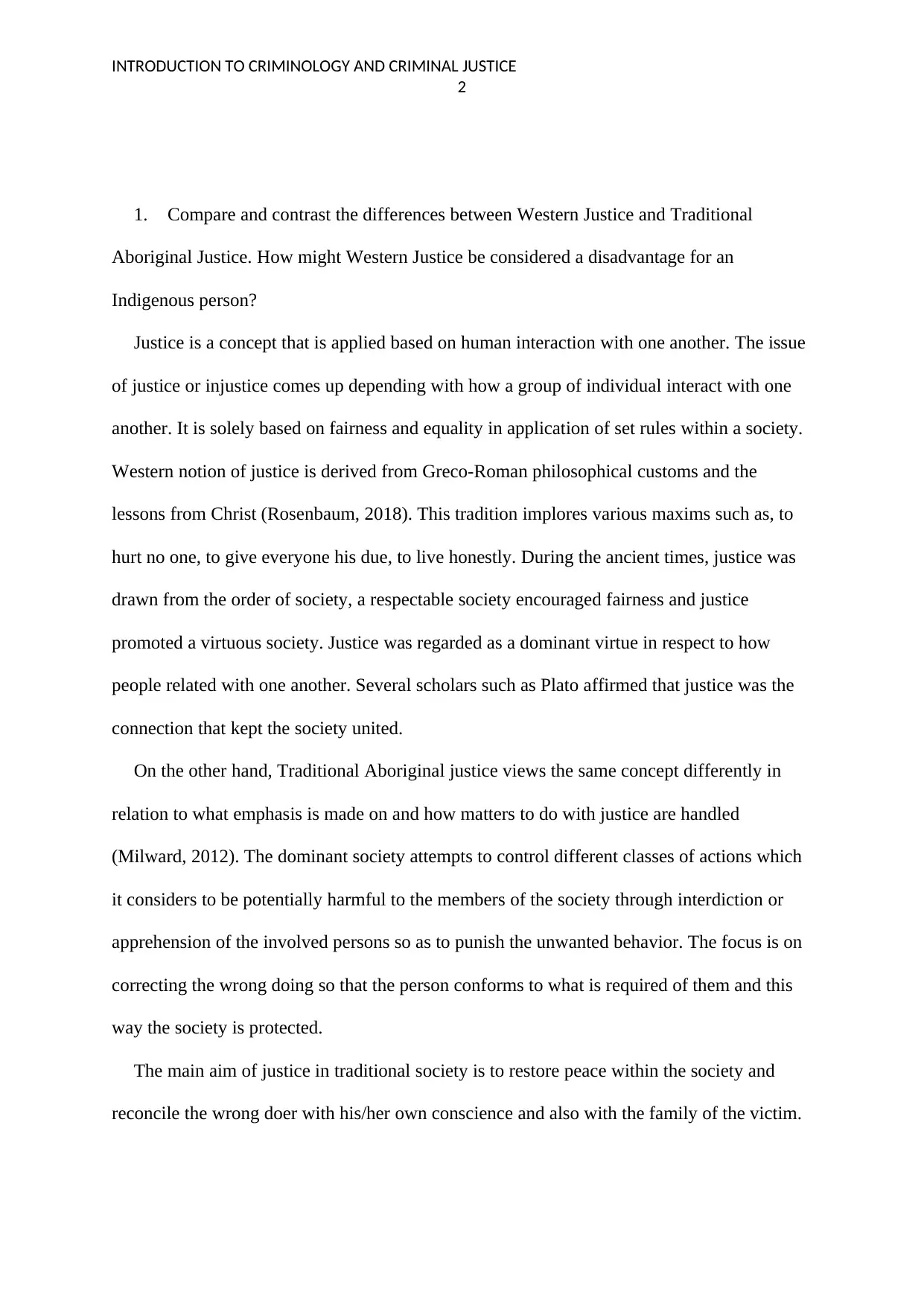
INTRODUCTION TO CRIMINOLOGY AND CRIMINAL JUSTICE
2
1. Compare and contrast the differences between Western Justice and Traditional
Aboriginal Justice. How might Western Justice be considered a disadvantage for an
Indigenous person?
Justice is a concept that is applied based on human interaction with one another. The issue
of justice or injustice comes up depending with how a group of individual interact with one
another. It is solely based on fairness and equality in application of set rules within a society.
Western notion of justice is derived from Greco-Roman philosophical customs and the
lessons from Christ (Rosenbaum, 2018). This tradition implores various maxims such as, to
hurt no one, to give everyone his due, to live honestly. During the ancient times, justice was
drawn from the order of society, a respectable society encouraged fairness and justice
promoted a virtuous society. Justice was regarded as a dominant virtue in respect to how
people related with one another. Several scholars such as Plato affirmed that justice was the
connection that kept the society united.
On the other hand, Traditional Aboriginal justice views the same concept differently in
relation to what emphasis is made on and how matters to do with justice are handled
(Milward, 2012). The dominant society attempts to control different classes of actions which
it considers to be potentially harmful to the members of the society through interdiction or
apprehension of the involved persons so as to punish the unwanted behavior. The focus is on
correcting the wrong doing so that the person conforms to what is required of them and this
way the society is protected.
The main aim of justice in traditional society is to restore peace within the society and
reconcile the wrong doer with his/her own conscience and also with the family of the victim.
2
1. Compare and contrast the differences between Western Justice and Traditional
Aboriginal Justice. How might Western Justice be considered a disadvantage for an
Indigenous person?
Justice is a concept that is applied based on human interaction with one another. The issue
of justice or injustice comes up depending with how a group of individual interact with one
another. It is solely based on fairness and equality in application of set rules within a society.
Western notion of justice is derived from Greco-Roman philosophical customs and the
lessons from Christ (Rosenbaum, 2018). This tradition implores various maxims such as, to
hurt no one, to give everyone his due, to live honestly. During the ancient times, justice was
drawn from the order of society, a respectable society encouraged fairness and justice
promoted a virtuous society. Justice was regarded as a dominant virtue in respect to how
people related with one another. Several scholars such as Plato affirmed that justice was the
connection that kept the society united.
On the other hand, Traditional Aboriginal justice views the same concept differently in
relation to what emphasis is made on and how matters to do with justice are handled
(Milward, 2012). The dominant society attempts to control different classes of actions which
it considers to be potentially harmful to the members of the society through interdiction or
apprehension of the involved persons so as to punish the unwanted behavior. The focus is on
correcting the wrong doing so that the person conforms to what is required of them and this
way the society is protected.
The main aim of justice in traditional society is to restore peace within the society and
reconcile the wrong doer with his/her own conscience and also with the family of the victim.
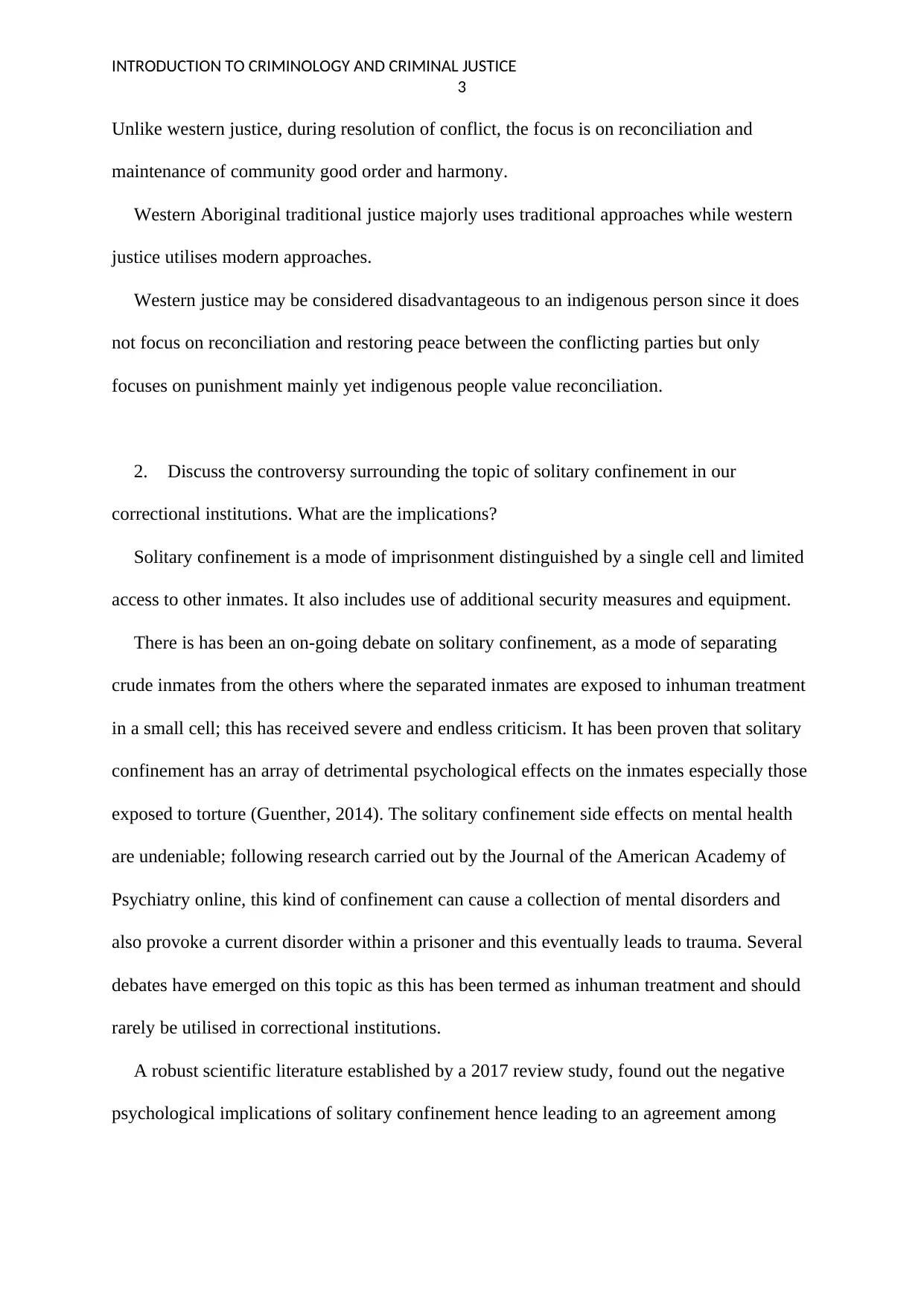
INTRODUCTION TO CRIMINOLOGY AND CRIMINAL JUSTICE
3
Unlike western justice, during resolution of conflict, the focus is on reconciliation and
maintenance of community good order and harmony.
Western Aboriginal traditional justice majorly uses traditional approaches while western
justice utilises modern approaches.
Western justice may be considered disadvantageous to an indigenous person since it does
not focus on reconciliation and restoring peace between the conflicting parties but only
focuses on punishment mainly yet indigenous people value reconciliation.
2. Discuss the controversy surrounding the topic of solitary confinement in our
correctional institutions. What are the implications?
Solitary confinement is a mode of imprisonment distinguished by a single cell and limited
access to other inmates. It also includes use of additional security measures and equipment.
There is has been an on-going debate on solitary confinement, as a mode of separating
crude inmates from the others where the separated inmates are exposed to inhuman treatment
in a small cell; this has received severe and endless criticism. It has been proven that solitary
confinement has an array of detrimental psychological effects on the inmates especially those
exposed to torture (Guenther, 2014). The solitary confinement side effects on mental health
are undeniable; following research carried out by the Journal of the American Academy of
Psychiatry online, this kind of confinement can cause a collection of mental disorders and
also provoke a current disorder within a prisoner and this eventually leads to trauma. Several
debates have emerged on this topic as this has been termed as inhuman treatment and should
rarely be utilised in correctional institutions.
A robust scientific literature established by a 2017 review study, found out the negative
psychological implications of solitary confinement hence leading to an agreement among
3
Unlike western justice, during resolution of conflict, the focus is on reconciliation and
maintenance of community good order and harmony.
Western Aboriginal traditional justice majorly uses traditional approaches while western
justice utilises modern approaches.
Western justice may be considered disadvantageous to an indigenous person since it does
not focus on reconciliation and restoring peace between the conflicting parties but only
focuses on punishment mainly yet indigenous people value reconciliation.
2. Discuss the controversy surrounding the topic of solitary confinement in our
correctional institutions. What are the implications?
Solitary confinement is a mode of imprisonment distinguished by a single cell and limited
access to other inmates. It also includes use of additional security measures and equipment.
There is has been an on-going debate on solitary confinement, as a mode of separating
crude inmates from the others where the separated inmates are exposed to inhuman treatment
in a small cell; this has received severe and endless criticism. It has been proven that solitary
confinement has an array of detrimental psychological effects on the inmates especially those
exposed to torture (Guenther, 2014). The solitary confinement side effects on mental health
are undeniable; following research carried out by the Journal of the American Academy of
Psychiatry online, this kind of confinement can cause a collection of mental disorders and
also provoke a current disorder within a prisoner and this eventually leads to trauma. Several
debates have emerged on this topic as this has been termed as inhuman treatment and should
rarely be utilised in correctional institutions.
A robust scientific literature established by a 2017 review study, found out the negative
psychological implications of solitary confinement hence leading to an agreement among
⊘ This is a preview!⊘
Do you want full access?
Subscribe today to unlock all pages.

Trusted by 1+ million students worldwide
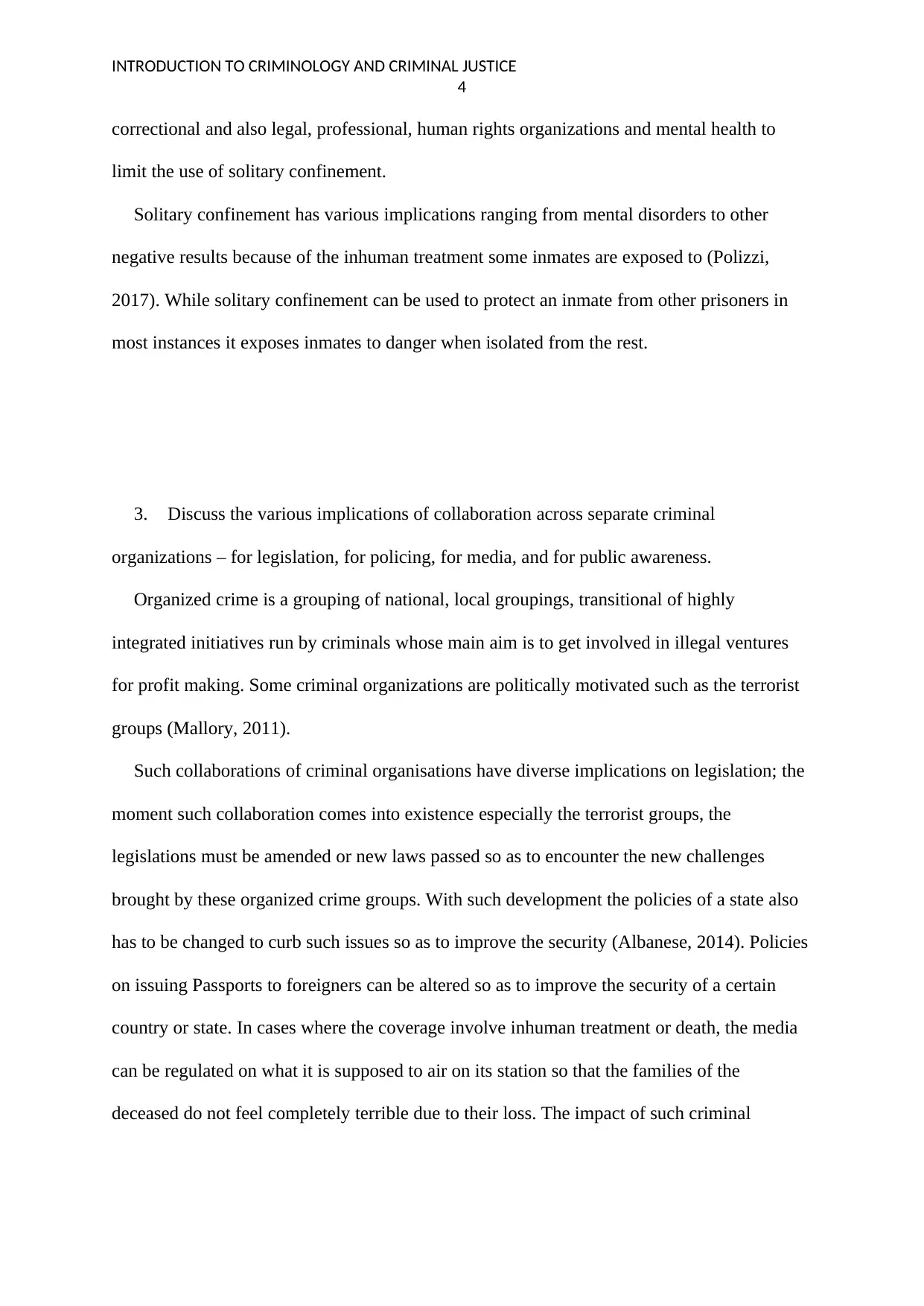
INTRODUCTION TO CRIMINOLOGY AND CRIMINAL JUSTICE
4
correctional and also legal, professional, human rights organizations and mental health to
limit the use of solitary confinement.
Solitary confinement has various implications ranging from mental disorders to other
negative results because of the inhuman treatment some inmates are exposed to (Polizzi,
2017). While solitary confinement can be used to protect an inmate from other prisoners in
most instances it exposes inmates to danger when isolated from the rest.
3. Discuss the various implications of collaboration across separate criminal
organizations – for legislation, for policing, for media, and for public awareness.
Organized crime is a grouping of national, local groupings, transitional of highly
integrated initiatives run by criminals whose main aim is to get involved in illegal ventures
for profit making. Some criminal organizations are politically motivated such as the terrorist
groups (Mallory, 2011).
Such collaborations of criminal organisations have diverse implications on legislation; the
moment such collaboration comes into existence especially the terrorist groups, the
legislations must be amended or new laws passed so as to encounter the new challenges
brought by these organized crime groups. With such development the policies of a state also
has to be changed to curb such issues so as to improve the security (Albanese, 2014). Policies
on issuing Passports to foreigners can be altered so as to improve the security of a certain
country or state. In cases where the coverage involve inhuman treatment or death, the media
can be regulated on what it is supposed to air on its station so that the families of the
deceased do not feel completely terrible due to their loss. The impact of such criminal
4
correctional and also legal, professional, human rights organizations and mental health to
limit the use of solitary confinement.
Solitary confinement has various implications ranging from mental disorders to other
negative results because of the inhuman treatment some inmates are exposed to (Polizzi,
2017). While solitary confinement can be used to protect an inmate from other prisoners in
most instances it exposes inmates to danger when isolated from the rest.
3. Discuss the various implications of collaboration across separate criminal
organizations – for legislation, for policing, for media, and for public awareness.
Organized crime is a grouping of national, local groupings, transitional of highly
integrated initiatives run by criminals whose main aim is to get involved in illegal ventures
for profit making. Some criminal organizations are politically motivated such as the terrorist
groups (Mallory, 2011).
Such collaborations of criminal organisations have diverse implications on legislation; the
moment such collaboration comes into existence especially the terrorist groups, the
legislations must be amended or new laws passed so as to encounter the new challenges
brought by these organized crime groups. With such development the policies of a state also
has to be changed to curb such issues so as to improve the security (Albanese, 2014). Policies
on issuing Passports to foreigners can be altered so as to improve the security of a certain
country or state. In cases where the coverage involve inhuman treatment or death, the media
can be regulated on what it is supposed to air on its station so that the families of the
deceased do not feel completely terrible due to their loss. The impact of such criminal
Paraphrase This Document
Need a fresh take? Get an instant paraphrase of this document with our AI Paraphraser
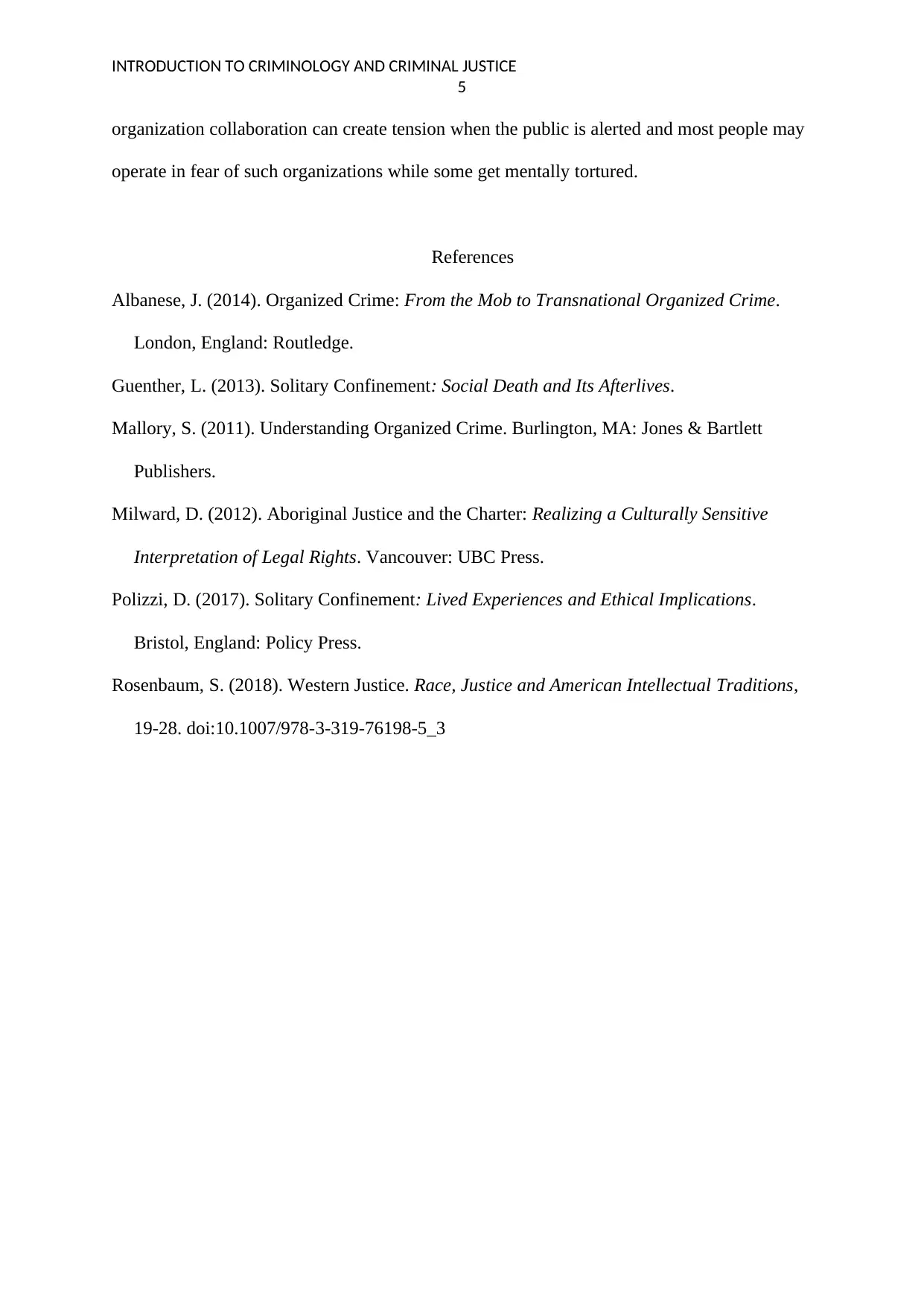
INTRODUCTION TO CRIMINOLOGY AND CRIMINAL JUSTICE
5
organization collaboration can create tension when the public is alerted and most people may
operate in fear of such organizations while some get mentally tortured.
References
Albanese, J. (2014). Organized Crime: From the Mob to Transnational Organized Crime.
London, England: Routledge.
Guenther, L. (2013). Solitary Confinement: Social Death and Its Afterlives.
Mallory, S. (2011). Understanding Organized Crime. Burlington, MA: Jones & Bartlett
Publishers.
Milward, D. (2012). Aboriginal Justice and the Charter: Realizing a Culturally Sensitive
Interpretation of Legal Rights. Vancouver: UBC Press.
Polizzi, D. (2017). Solitary Confinement: Lived Experiences and Ethical Implications.
Bristol, England: Policy Press.
Rosenbaum, S. (2018). Western Justice. Race, Justice and American Intellectual Traditions,
19-28. doi:10.1007/978-3-319-76198-5_3
5
organization collaboration can create tension when the public is alerted and most people may
operate in fear of such organizations while some get mentally tortured.
References
Albanese, J. (2014). Organized Crime: From the Mob to Transnational Organized Crime.
London, England: Routledge.
Guenther, L. (2013). Solitary Confinement: Social Death and Its Afterlives.
Mallory, S. (2011). Understanding Organized Crime. Burlington, MA: Jones & Bartlett
Publishers.
Milward, D. (2012). Aboriginal Justice and the Charter: Realizing a Culturally Sensitive
Interpretation of Legal Rights. Vancouver: UBC Press.
Polizzi, D. (2017). Solitary Confinement: Lived Experiences and Ethical Implications.
Bristol, England: Policy Press.
Rosenbaum, S. (2018). Western Justice. Race, Justice and American Intellectual Traditions,
19-28. doi:10.1007/978-3-319-76198-5_3
1 out of 5
Your All-in-One AI-Powered Toolkit for Academic Success.
+13062052269
info@desklib.com
Available 24*7 on WhatsApp / Email
![[object Object]](/_next/static/media/star-bottom.7253800d.svg)
Unlock your academic potential
Copyright © 2020–2025 A2Z Services. All Rights Reserved. Developed and managed by ZUCOL.